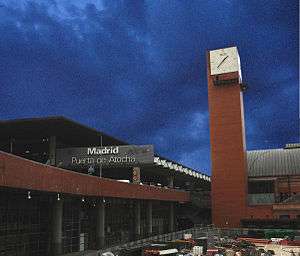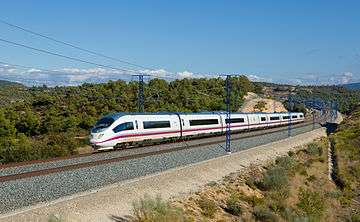Madrid Atocha railway station
 | |||||||||||
| Location |
Arganzuela, Madrid Spain | ||||||||||
| Coordinates | 40°24′24″N 3°41′22″W / 40.406528°N 3.689373°WCoordinates: 40°24′24″N 3°41′22″W / 40.406528°N 3.689373°W | ||||||||||
| Owned by | Adif | ||||||||||
| Operated by | Renfe | ||||||||||
| Line(s) |
From Puerta de Atocha:
From Atocha-Cercanias: | ||||||||||
| Other information | |||||||||||
| Fare zone | A | ||||||||||
| History | |||||||||||
| Opened | 25 July 1988 | ||||||||||
| Services | |||||||||||
| |||||||||||
| Location | |||||||||||
 Madrid Atocha Location within Madrid | |||||||||||
Madrid Atocha (Spanish: Estación de Madrid Atocha, also named Madrid Puerta de Atocha) is the largest railway station in Madrid. It is the primary station serving commuter trains (Cercanías), intercity and regional trains from the south, and the AVE high speed trains from Barcelona (Catalonia), Zaragoza (Aragon), Seville (Andalusia) and Valencia (Levante Region). These train services are run by the Spanish national rail company, Renfe.
Overview
The station is in the Atocha neighborhood of the district of Arganzuela. The original façade faces the Plaza del Emperador Carlos V, a site at which a variety of streets converge, including the Calle de Atocha, Paseo del Prado, Paseo de la Infanta Isabel, Avenida de la Ciudad de Barcelona, Calle de Méndez Álvaro, Paseo de las Delicias, Paseo de Santa María de la Cabeza, and Ronda de Atocha.
The Atocha station is really a railway complex, formed by the Madrid Atocha Cercanías and Madrid Puerta de Atocha stations of the Spanish national railways and a station of the Madrid underground called Atocha RENFE.
History

At this site, Madrid's first railway station was inaugurated on 9 February 1851 under the name Estación de Mediodía (Atocha-Mediodía is now the name of an area of the Arganzuela district, and means south in old Spanish).
After the building was largely destroyed by fire, it was rebuilt and reopened in 1892. The architect for the replacement, in a wrought iron renewal style was Alberto de Palacio Elissagne, who collaborated with Gustave Eiffel. Engineer Henry Saint James also took part in the project.[1] The name Atocha has become attached to the station because of the nearby basilica dedicated to Our Lady of Atocha. The train platforms were partly covered by a roof in the form of inverted hull with a height of approximately 27 meters and length of 157 meters. The steel and glass roof spreads between two brick flanking buildings.
This complex of railway tracks expanded through the years. In 1985, a project of complete remodeling began, based on designs by Rafael Moneo. In 1992, the original building was taken out of service as a terminal, and converted into a concourse with shops, cafés, and a nightclub. Like the Orsay Museum in Paris, the concourse has been given a new function, this time a stunning 4,000 m2 (43,056 sq ft) covered tropical garden.
A modern terminal was also designed by Moneo, and built in adjacent land to serve both the new AVE trains and local commuter lines. The main lines end in the new terminal; commuter train platforms are located underground, at the ingress to a rail tunnel extending northward under the Paseo de la Castellana. The station is served by two Madrid Metro stations, Atocha and Atocha Renfe. The latter was added when the new terminal building was constructed and is directly linked to the railway station.
11-M Train Bombings of 2004
On 11 March 2004, packed arriving commuter trains were bombed in a series of coordinated bombings, killing 191 people and wounding 1,800. The official investigation by the Spanish Judiciary determined the attacks were directed by a terrorist cell.
Memorials to the 2004 Attack

On 10 June 2004, a somber and minimalist Atocha station memorial was dedicated for the victims of the Attack. The monument includes a virtual shrine. Visitors to the attacked stations can leave a hand silhouette and a message through special-purpose consoles. A second monument to this event, known as 11-M in Spain, is the Bosque del Recuerdo ("the Forest of Remembrance") in the Parque del Buen Retiro near Atocha. This monument is made up of 192 olive and cypress trees, one for each person who died on that day, with a tree also planted in remembrance of the police officer who died on 3 April 2004, along with seven of the perpetrators whose capture was underway. Initially inaugurated as the Bosque de los Ausentes ("Forest of the Departed"), on the first anniversary of the devastating attack, on 11 March 2005, the site was renamed the following year. The forest is surrounded by a stream, with water as the symbol of life.
Services
Trains from Puerta de Atocha
| Preceding station | Renfe Operadora | Following station | ||
|---|---|---|---|---|
| Terminus | Avant | Terminus |
||
| Avant | Ciudad Real toward Puertollano |
|||
| Terminus | AVE | Ciudad Real toward Seville-Santa Justa |
||
| AVE | Ciudad Real toward Málaga María Zambrano |
|||
| AVE | toward Valencia-Joaquín Sorolla |
|||
| AVE | toward Alicante |
|||
| AVE | toward Barcelona Sants |
|||
| AVE | toward Figueres-Vilafant |
|||
| AVE | toward Huesca |
|||
| AVE | toward Marseille-St-Charles |
|||
| Terminus | Alvia | Ciudad Real toward Cádiz |
||
| Alvia | Córdoba toward Huelva Término |
|||
| Alvia | Albacete-Los Llanos toward Valencia-Joaquín Sorolla |
|||
| Alvia | toward Logroño |
|||
| Alvia | toward Pamplona |
|||
| Alvia | toward Vinaroz |
|||
toward Gijón | Alvia | toward Alicante |
||
toward A Coruña | Alvia | |||
toward Pontevedra | Alvia | |||
toward Santander | Alvia | |||
| Alvia | Ciudad Real toward Cádiz |
|||
toward Gijón | Alvia | |||
| Alvia | Ciudad Real toward Oropesa del Mar |
Trains from Atocha-Cercanías
| Preceding station | Renfe Operadora | Following station | ||
|---|---|---|---|---|
| Terminus | Alaris | Albacete-Los Llanos toward Castellón de la Plana | ||
| Alaris | Albacete-Los Llanos toward Valencia Nord | |||
| Alaris | Albacete-Los Llanos toward Gandía | |||
| Alaris | Albacete-Los Llanos toward Oropesa | |||
| Terminus | Altaria | Ciudad Real toward Algeciras |
||
| Altaria | Ciudad Real toward Granada |
|||
| Altaria | Alcázar de San Juan toward Murcia del Carmen |
|||
| Altaria | Alcázar de San Juan toward Cartagena |
|||
| Terminus | Talgo | Alcázar de San Juan | ||
| Talgo | Alcázar de San Juan | |||
| Terminus | Media Distancia 52 | Leganés toward Badajoz |
||
| Terminus | Media Distancia R-1 | toward Ávila |
||
| Terminus | Media Distancia R-2 | toward Segovia |
||
| Terminus | Media Distancia R-6 | Aranjuez toward Valencia-Sant Isidre |
||
| Terminus | Media Distancia R-7 | Aranjuez toward Albacete-Los Llanos |
||
| Terminus | Media Distancia R-8 | Aranjuez toward Ciudad Real |
||
| Terminus | Aranjuez toward Jaén |
|||
| Terminus | Media Distancia R-10 | Aranjuez toward Badajoz |
Suburban trains
| Preceding station | Cercanías Madrid | Following station | ||
|---|---|---|---|---|
toward Aeropuerto T4 | C-1 | toward Príncipe Pío |
||
toward Chamartín | C-2 | Asamblea de Madrid-Entrevías toward Guadalajara |
||
toward El Escorial | C-3 | toward Aranjuez |
||
toward Alcobendas-San Sebastián de los Reyes or Colmenar Viejo | C-4 | toward Parla |
||
Embajadores toward Móstoles-El Soto | C-5 | toward Humanes |
||
toward Fuente de la Mora | C-7 | Asamblea de Madrid-Entrevías toward Alcalá de Henares |
||
toward Alcalá de Henares |
||||
toward El Escorial or Cercedilla | C-8 | Terminus | ||
toward Fuente de la Mora | C-10 | toward Villalba |
See also
References
- ↑ "Madrid's Official College of Architects website". 212.145.146.10. Retrieved 24 December 2012.
External links
| Wikimedia Commons has media related to Atocha train station. |
- Atocha at Google Maps
- Madrid train services visitor guide (English)
- The 11-M memorial website (in Spanish)
- of Remembrance
